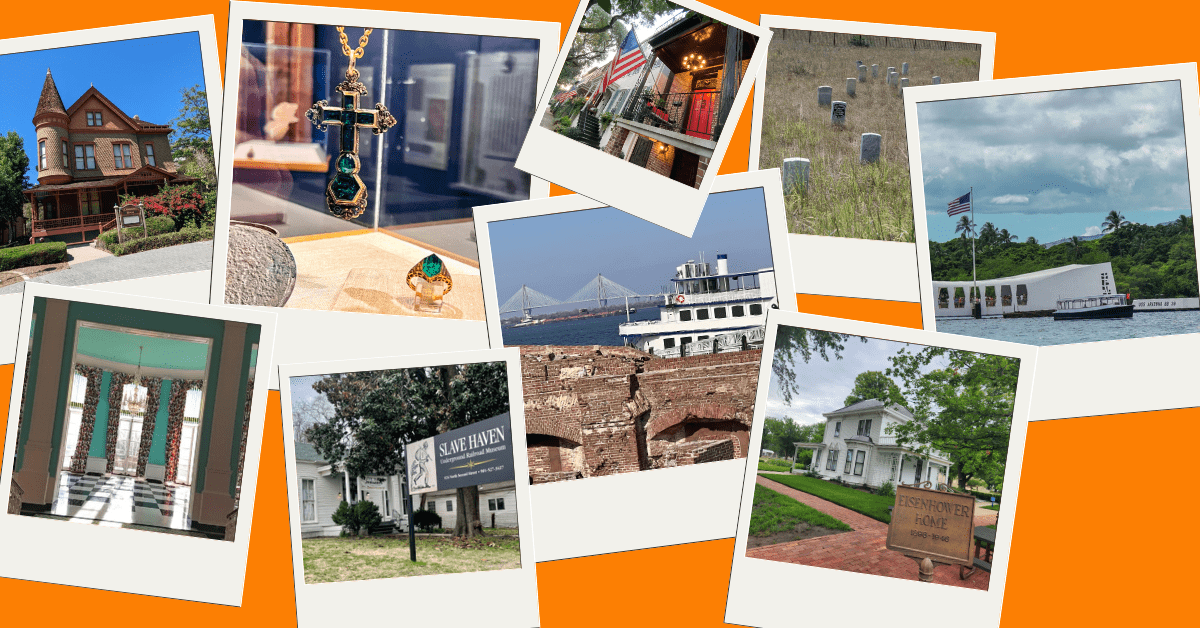Embark on a captivating journey through the annals of American history as we explore some of the nation’s most intriguing and historically significant destinations. From the hallowed halls of Independence Hall in Philadelphia, where the foundations of the United States were laid, to the haunting ruins of Fort Sumter in Charleston, South Carolina, where the Civil War ignited, each place holds stories of courage, sacrifice, and transformation. Join us as we delve into the rich tapestry of the past, uncovering the triumphs and tribulations that have shaped the country we know today. Step back in time and embrace the allure of history as we traverse the historic districts, visit museums and monuments, and walk in the footsteps of those who came before us, leaving an indelible mark on the American story.
Philadelphia, PA
Contributed by Lanie van der Horst of Make More Adventures
Disclosure: Some links on our site are affiliate links. If you purchase a linked item, we will make a commission, at no extra charge to you.
Known as the birthplace of the United States of America, Philadelphia, Pennsylvania is where both the Declaration of Independence and the US Constitution were written. Philadelphia played a big role in the American Revolution and was once the capital of the USA. Today, visitors are able to view many of the items that shaped the country by visiting Independence Hall.
Philadelphia’s Historic District houses Independence Hall and other notable historical sites. The Liberty Bell can be seen as well as where the first American flag was made at Betty Ross House. Both George Washington and John Adams lived in the President’s House in Philadelphia and more can be learned about that time at the Museum of the American Revolution.
The city of Philadelphia offers a look into America’s past and is also rich in art, food, and culture. Philadelphia is perfect for both adults and kids who want to learn about the history of the USA.
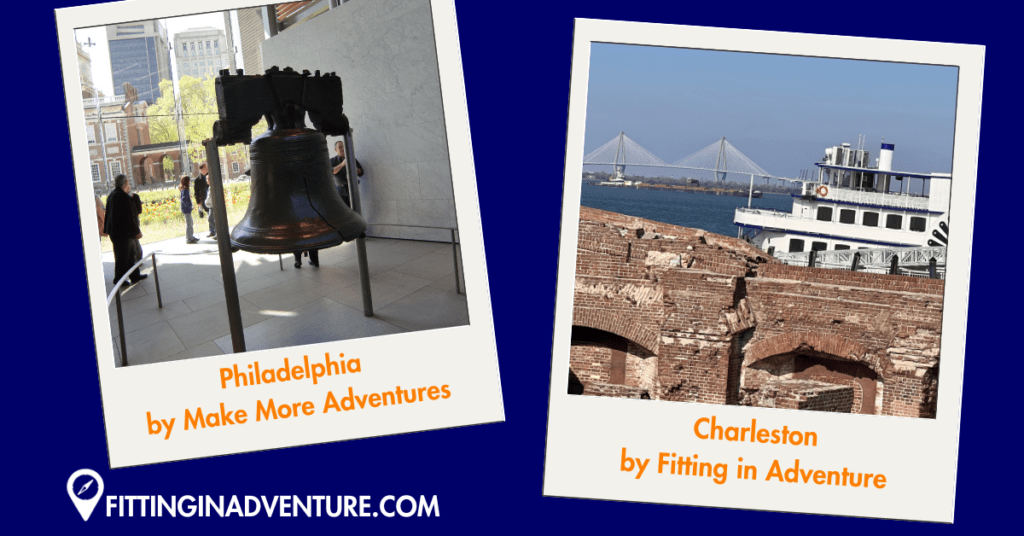
Charleston, South Carolina
Contributed by Angela of Fitting in Adventure
Charleston, South Carolina, is a city with a rich history and undeniable Southern charm. It is a treasure trove of captivating historic sites, drawing travelers from far and wide to immerse themselves in its storied past.
For history aficionados, a visit to Fort Sumter National Monument is a must. This hallowed ground is where the first shots of the American Civil War were fired. Visitors can take a ferry to the fort and explore the haunting ruins, reflecting on the significant events that shaped the nation.
Wandering the historic district, visitors encounter a captivating maze of cobblestone streets flanked by elegant antebellum mansions and colonial architecture. Charleston City Market, established in 1788, stands as a vibrant testament to the city’s mercantile heritage. Here, visitors can find an array of souvenirs, local crafts, and delectable low-country cuisine.
A trip back in time continues with a visit to the Old Exchange and Provost Dungeon. This remarkable building dates back to 1767 and has served as a marketplace, a meeting hall, and a prison. Today, it stands as a museum that eloquently narrates Charleston’s enthralling history.
In addition to its historical significance, Charleston also allures thrill-seekers with ghost tours that meander through the city’s haunted past. The whispers of the past seem to echo through the cobblestone streets, adding an air of mystery and intrigue to the already enchanting cityscape.
Completing the Charleston experience is a delectable exploration of Lowcountry cuisine. The city’s culinary delights entice visitors with a fusion of flavors, showcasing the area’s rich culinary heritage.
Charleston, with its blend of captivating history, alluring architecture, and soul-warming Southern hospitality, is an inviting destination for those eager to explore the past and savor the beauty of the present.
New Orleans, LA
Contributed by Angela of Fitting in Adventure
New Orleans, with its captivating and diverse history, traces its origins back to the French settlement in 1718. Over the years, this vibrant city has been under the control of the French, Spanish, and Americans, giving rise to a tapestry of historical stories, battles, and remarkable characters.
Among the city’s most renowned historical sites, the French Quarter takes center stage. As the oldest district, it boasts a plethora of historic buildings, including the iconic St. Louis Cathedral and the Cabildo, which together offer a glimpse into the city’s storied past. Meanwhile, the Garden District, with its stunning antebellum mansions, exudes timeless charm.
For those seeking a deeper understanding of World War II history, the National World War II Museum stands as a beacon of knowledge, housing an extensive collection dedicated to the global conflict.
New Orleans museums & tours offer a treasure trove of educational experiences. The Historic New Orleans Collection presents a range of tour options, from walking to bus and carriage tours, providing an immersive exploration of the city’s heritage. Additionally, the Louisiana State Museum offers enlightening exhibits that shed light on the city’s past.
Beyond the well-known attractions, New Orleans boasts numerous other historical gems worth exploring. The site of the Battle of New Orleans, a pivotal moment in the War of 1812, remains an intriguing destination for history enthusiasts. Furthermore, the French Market, an operational historic marketplace since 1791, beckons visitors with its timeless allure.
Savannah, Georgia
Contributed by Angela of Fitting in Adventure
Savannah, Georgia is one of the most historic cities in the United States. Founded in 1733 by James Edward Oglethorpe, Savannah was the first planned city in the country. Oglethorpe’s grid-like layout is still evident today by visiting its’ historic squares. Savannah’s squares are flanked by historic Antebellum homes, many of which are open for public tours offering a glimpse into the lives of the wealthy planters and merchants who once lived in Savannah.
Another must-see for history lovers is Fort Pulaski. This 19th-century fort played a significant role in the Civil War. It was here that Union forces successfully bombarded the fort, leading to its surrender. With its antebellum homes, historic squares, and Civil War sites, Savannah is a city that will transport you back in time.

9/11 Memorial & Museum, New York City, NY
Contributed by Claudia Tavani of My Adventures Across The World
9/11 Memorial and Museum is an absolute must-see to learn about one of the most recent and devastating chapters of the history of the United States. While today this is one of the most popular attractions in New York City, this is not a place you should visit lightheartedly, but it is meant to make you think about the devastation and suffering humans can cause, and how they can fight back and get back on their feet.
The main thing to see in the 9/11 Memorial is “Reflecting Absence”. This is actually two reflecting pools that were built where the Twin Towers were located and are the largest man-made waterfall in North America. Running along the monument, you can see the names of the victims of the 2001 terrorist attack, along with those of the ones who died in the 1993 attack.
There’s also the FDNY Memorial which is dedicated to the firefighters who died in the effort to save lives and extinguish the fires of the fallen towers; and the Horse Soldier Statue (the official name is America’s Response Monument, which is a tribute to the men and women who fought the Afghan war immediately after the attacks. Finally, you should spot the Survivor Tree, which actually is a number of white oak trees running along the Memorial.
Inside, the museum is meant to walk you through the events of 9/11: the attacks, the before and the after. There are photos of the victims too.
Pearl Harbor
Contributed by Noel Morata of Hawaii Travel & Lifestyle
Of all the free things to do in Honolulu, the top attraction to visit on the island is Pearl Harbor. Not only is the visit managed by the National Parks Service but visiting is totally free when you book a reservation on their website. Pearl Harbor is a historic and cultural place to visit and an educational center with museums, memorials a fantastic video, and additional attractions you can visit for a nominal fee.
The historic site that is open to visitors (this is still a naval base in full operation) showcases the bravery and infamous day on December 7th, 1941 when the Japanese pulled a surprising attack on Pearl Harbor with a naval fleet that destroyed most of the American facility and warships that were docked in the piers and naval base. This created the American entry to World War II in Asia with hard-fought battles against the Japanese aggressor and culminated with the dropping of the atomic bomb on two major cities of Japan and forcing a complete surrender.
Despite the ominous tragedy, this site is a dedication and beautiful presentation of the effort to defend the base and Oahu in general at that time. Fantastic collections, memorabilia, dioramas, and displays are found in the museums along with a fantastic ferry ride to the USS Arizona Memorial which is scenic and very memorable.
Make the time to visit Pearl Harbor when you get a chance to explore the different attractions around Honolulu and you will learn more about Hawaii and American perseverance and bravery.

Alexandria, VA
Contributed by Julie McCool of Fun in Fairfax VA
Unique historic sites from throughout U.S. history are among the best places to visit in Alexandria Virginia. Head to Old Town Alexandria to explore American history from Colonial times to the present. Here you’ll find a walkable neighborhood of beautifully preserved buildings and streets dotted with interesting museums. Watch your footing as you navigate the brick sidewalks!
At the Stabler-Leadbeater Apothecary, tour a pharmacy frozen in time where unicorn root, dragon’s blood, and a medicine order from Martha Washington still inhabit the shelves. Another must-visit (and highly Instagrammable) spot is the colorful Spite House, a 7-foot-wide home built to block a noisy alley. Nearby Captain’s Row features a cobblestone street bordered by stately homes.
When you need a break, dine at Gadsby’s Tavern, which has served meals to notable guests like George Washington and Thomas Jefferson since 1770. Of course, there are many other excellent restaurants and shops in Old Town, many of them clustered on King Street. If time allows, you can tour the Potomac River on the Tall Ship Providence. Or walk the waterfront trail to Jones Point Park which preserves the original boundary of Washington DC.
Appomattox Courthouse
Contributed by Angela of Fitting in Adventure
On April 9, 1865, General Robert E. Lee surrendered to General Ulysses S. Grant at Appomattox Court House, Virginia effectively ending the American Civil War and reuniting the country.
The surrender took place at the McLean House, a private home that is now a National Historic Park. Visitors can walk through the parlor where Lee and Grant met, and see the table where they signed the terms of surrender. The house is also home to several exhibits about the Civil War, including artifacts from the surrender.
The McLean House is a significant historical site, and it is a powerful experience to walk through the room where the war ended. The house is a reminder of the sacrifices made during the war, and is a symbol of the hope and reconciliation that followed.

Little Rock, AR
Contributed by Charles McCool of McCool Travel
Little Rock Central High School (LRCHS) is the only school that is a National Park property and one of the top places to visit in Little Rock Arkansas. The school was center stage in the U.S. Civil Rights struggle in the late 1950s. The Little Rock Nine was a group of African-American children—among hundreds who initially registered—who attended the all-white high school after the landmark Brown vs Board of Education legal case. After months of lawsuits, harassment, assassination threats, and physical and emotional violence, the students entered LRCHS in early September 1957 only to be snuck out a side entrance because of extreme violence. President Eisenhower deployed the National Guard and Army Airborne to Little Rock to escort the students three weeks later (and the rest of the school year).
66 years later, eight of the American heroes are still alive and most are actively campaigning for equality. In addition to visiting Little Rock Central High School National Historic Site (take the recommended ranger-led tour!), spend time at the nearby Clinton Presidential Center. William Clinton was the 42nd US President after serving as Arkansas governor for 12 years.
Abilene, KS
Contributed by Michelle Moyer of Moyer Memoirs Empty Nest Travel Adventures
Abilene, Kansas is a great small town for US history lovers. In fact, the town has even won awards for the best Historic Small Town and Best Promotion of a Historic Place. Abilene is a short day trip 159 miles west of Kansas City and full of history.
The early years of the town saw herds of longhorns going through it via the Kansas Pacific Railroad. It became a prominent cattle shipping center that resulted in much prosperity. With that boom came the lawless cowboys that needed to be tamed. One such famous marshal was Wild Bill Hickok. Abilene’s wild roots can be seen around the city, but especially in Old Abilene Town. The old ghost town is complete with wooden boardwalks, saloons, and an occasional (fake) gunfight.
The small town of Abilene was the boyhood home of President Dwight D. Eisenhower and there is no shortage of historical memorabilia from that era. The Eisenhower Presidential Museum and Library houses so many artifacts from the world wars and Eisenhower’s presidency that any history-lover can spend a full day going through it all.
End your weekend in Abilene Kansas with a ride on the historic Abilene and Smoky Valley Railroad. It is a living history museum, staffed by volunteers dedicated to preserving the legacy of the railroad industry. As the only steam locomotive in Kansas, it will take you through the Kansas countryside on what seems to be a trip through time.
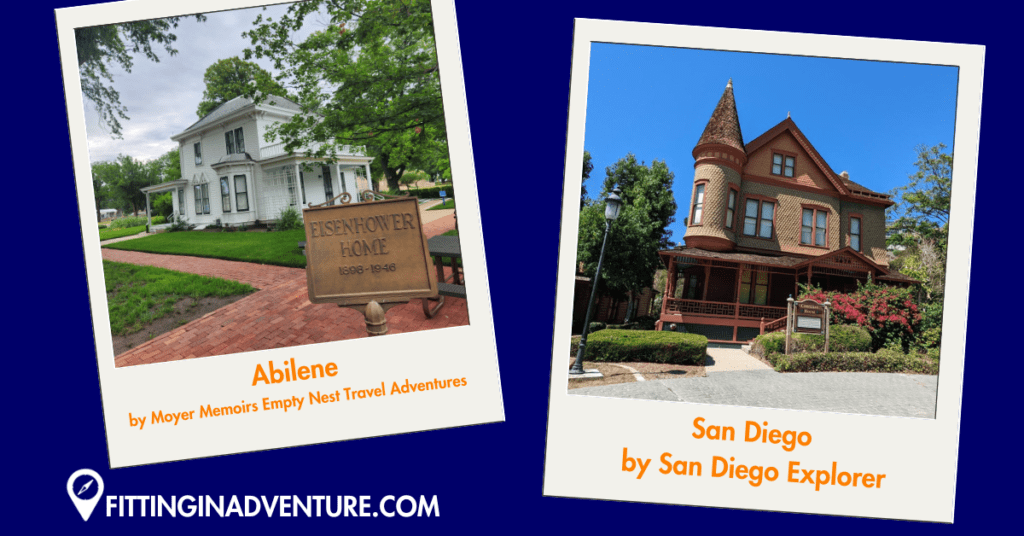
San Diego
Contributed by Maria Haase of SanDiegoExplorer.com
Old Town San Diego is often referred to as the “Birth Place of California”. Of course, the area now known today as California had been settled for centuries by Native tribes, such as the Kumeyaay and Tipai-Ipai. However, as it is the first settlement of Western explorers and colonizers on the West Coast of the modern-day USA, it definitely is one of the most historic places in California and should not be missed by history buffs.
The Old Town San Diego State Historic Park is like an open-air museum with a mix of historic buildings preserved for teaching visitors about how life was like for the early European settlers. There is an old school, a blacksmith shop where tourists can watch how metal was formed during those days, a saloon and smoke shop, and a fantastic Tourist information center that gives a lot of information about the founding of San Diego as the first permanent settlement in California. Lovers of Victorian architecture should not miss the “Painted Ladies of San Diego”, a row of stunning and colorful Victorian houses on Wallace Street.
Visitors who are into the occult and spooky side of American History should add the Whaley House to their Old Town San Diego itinerary. This Court House and execution grounds, turned convenience store, turned private residence is known as one of the most haunted houses in the US.
Old Town San Diego is also known as a great spot to experience Mexican culture and, of course, Mexican food. There are a plethora of shops and markets selling decor and trinkets from South of the border, and there are many cultural festivities and events happening in Old Town that make it worth a visit.
Little Bighorn Battlefield National Monument
Contributed by Tom Bartel of TravelPast50.com
It’s best to make time for at least a day-long visit to the Little Bighorn Battlefield National Monument in southeastern Montana. A brief visit isn’t enough to see, or fully appreciate, the size and scope of the entire battlefield.
The Battle of the Little Bighorn, also known as “Custer’s Last Stand,” took place on June 25, 1876 in what was then the Montana Territory. The battle was an overwhelming victory for the approximately 2000 Lakota (Sioux,) Northern Cheyenne, and Arapaho warriors.
There is a long road, about five miles, between the Last Stand Hill, where Custer was killed, and the hilltops where the US Army forces under his subordinate officers Major Marcus Reno and Captain Frederick Benteen were able to dig in enough to hold off the attacks.
In addition to the connecting road, there are two walking paths, each about half a mile long, with signs which explain the flow of the battle. At the trailheads, there are brochures that you can buy (or borrow for the length of your walk.) The brochures tell you what happened as you walk among the white headstones placed where soldiers fell – and the few red-colored headstones where Cheyenne and Sioux warriors fell. If you can, be sure to stay for a Park Ranger-led lecture on the history of the battle.
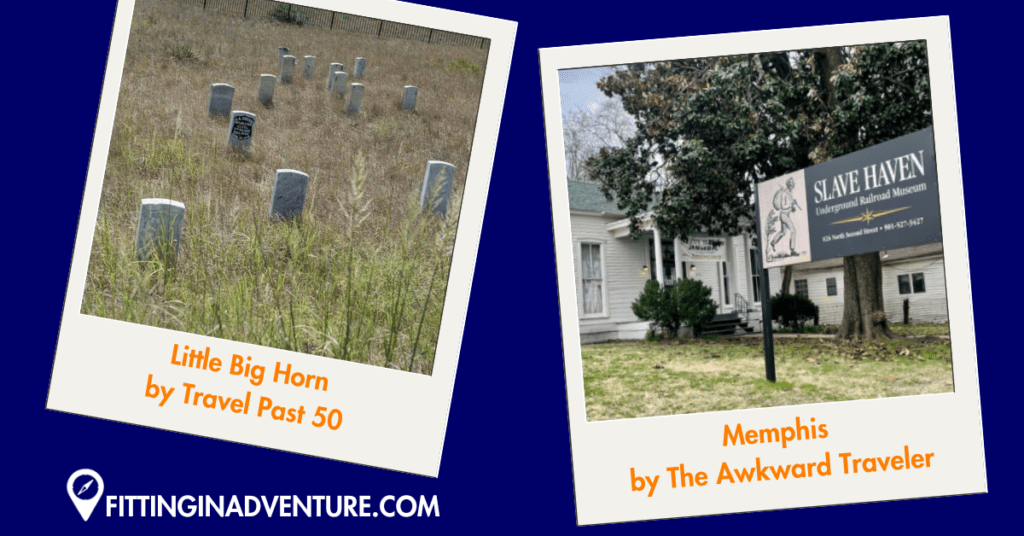
Memphis
Contributed by Kay Kingsman of The Awkward Traveller
While often overlooked by its flashier Tennessee neighbor Nashville, the smaller city of Memphis is actually one of the best places for US history. Memphis is a destination rooted in the country’s history of music, civil rights, and how closely intertwined those two cultural facets really are. Prior to the Civil War, a quarter of the population in Memphis were enslaved. But that didn’t mean there wasn’t hope. The Slave Haven Underground Railroad Museum is the first and only museum in the country that focuses on the treacherous journey to freedom for those enslaved, housed in an actual former safe stop along the Underground Railroad.
The Stax Museum is another great spot in Memphis for US history, as it was one of the only record labels in the late 1950s with an integrated team and promoting both Black and white artists. The soul music produced at Stax Records played an important role in the Civil Rights Movement, and is one of the pillars of American music today. And speaking of the Movement, before you leave Memphis, check out the National Civil Rights Museum. Located in the former Lorraine Motel, the site of Dr Martin Luther King Jr.’s assassination, the museum thoughtfully, but thoroughly, details the history of Civil Rights activism in the US and its ongoing resistance to oppression still at play today.
Greenbriar Bunker Tour
Contributed by Rachel of Means to Explore
During the Cold War, the US government secretly approved and funded the construction of a nuclear fallout shelter for Congress in case of an attack on Washington, DC. President Eisenhower easily convinced the owner of the luxury Greenbrier Resort in White Sulphur Springs, WV to hide the important bunker beneath his hotel.
The bunker was built in plain sight but disguised under an expansion to the hotel. For decades it remained top secret yet ready to be used at a moment’s notice. Most of the hotel staff had no idea it was there and were just as surprised as the public when a reporter exposed its existence and location in the late 1990s.
Today, the secret bunker has been decommissioned and turned into a tourist attraction for the hotel. You can tour everything: the decontamination chambers, dorm rooms, auditoriums, media rooms, and cafeteria. Kids especially will enjoy the enormous blast door that even they can move by themselves!
You don’t have to be a resort guest to tour the bunker, just one of the many key tips to know before you explore the Greenbrier Bunker. Splurge for a longer stay at the Greenbrier Resort, or add a stop for the bunker tour to your next Eastern USA road trip!
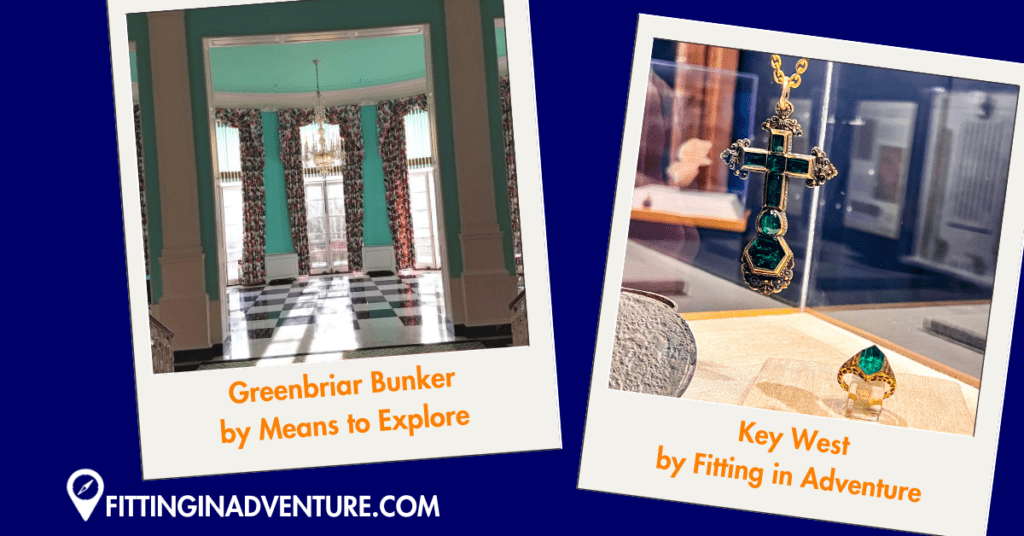
Unexpected History in Key West, Florida
Contributed by Angela of Fitting in Adventure
Key West, renowned for its laid-back ambiance, vibrant nightlife, and breathtaking natural beauty, holds a captivating history that often goes overlooked.
In 1822, Key West and the Florida Keys were claimed by the United States, heralding a new era of growth and significance. Its strategic location bolstered trade and commerce, and the island assumed a pivotal military role. During the Civil War, it emerged as a Union stronghold, witnessing pivotal battles.
Post-war, Key West thrived, emerging as a prominent hub for fishing and cigar industries. Its vibrant arts and culture scene drew luminaries like Ernest Hemingway and Tennessee Williams in the early 20th century, making Key West a hub for creativity.
In a curious twist, in the 1980s, Key West seceded from the United States, adding a unique chapter to its history. The event is celebrated annually with the Conch Republic Independence Festival.
Today, Key West remains a busy tourist destination. Noteworthy museums, including the Key West Museum, Mel Fisher Museum, and Key West Lighthouse, offer a captivating glimpse into the island’s past. Historic landmarks like the nearby Dry Tortugas, Fort Zachary Taylor, the Key West Cemetery, and the Ernest Hemingway Home and Museum further enrich the experience.
While Key West history may not be the first place that comes to mind, its rich and enthralling past begs exploration. For those seeking an unforgettable journey into American history against an idyllic backdrop, Key West stands as the perfect destination.

